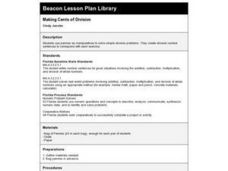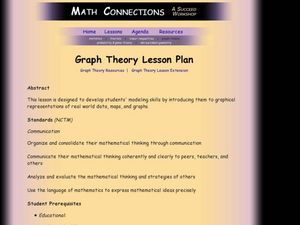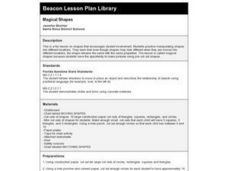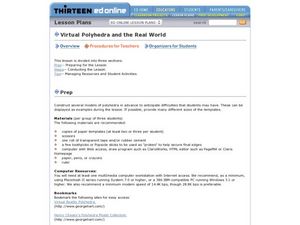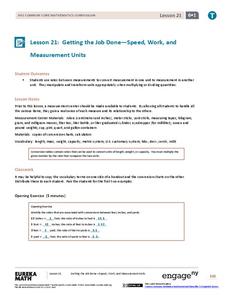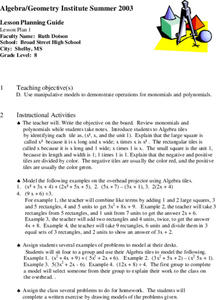Curated OER
Making Cents of Division
Third graders use pennies as manipulatives to solve simple division problems. They create division number sentences to correspond with each exercise. This is a good, hands-on way to teach the concept of division.
Curated OER
Graph Theory
Students explore the concept of graph theory. In this graph theory instructional activity, students participate in hands-on activities that enforce graph theory. Students manipulate graph applets on the internet. Students create a...
Curated OER
Orthographic Drawings
Students investigate the creation of three dimensional drawings. In this geometry instructional activity, students analyze and complete orthographic drawings. They Cabri software to manipulate and move the drawings around.
Curated OER
Operations of Polynomials
Students investigate the concept of manipulating polynomials. They go through the process of using algebra tiles in order to practice grouping of like terms and model the solving process.
Curated OER
Pizza Fractions
First graders identify a whole and the fractions 1/4, 1/2, and 3/4 using pizza. This is a very nice lesson, in that not only do students practice their fractions, they also get to eat the pizza at the end of the lesson!
Curated OER
Magical Shapes
First graders practice manipulating shapes into different locations. They see that even though shapes may look different when they are moved into different locations, the shape remains the same with the same properties. They make...
Curated OER
Constructing Polyhedra
Students explore the concept of polyhedra. In this polyhedra lesson, students use the Internet to manipulate virtual polyhedra models. Students create polyhedra models from straws, toothpicks, cardboard, Plexiglas, and other materials.
Curated OER
Area and Measurements
Students measure the area using feet and yard. For this algebra lesson, students draw and manipulate shapes to calculate the area. They measure the relationship of area between the two units.
Curated OER
Fun With Symmetry
Students manipulate shapes to find multiple lines of symmetry. They use color to visualize the lines of symmetry.
Curated OER
Addition and Subtraction Facts to 20
Students act out computation problems. In this addition and subtraction lesson, students act out an addition story and write an addition sentence for it. Students continue this activity and answer the provided questions.
EngageNY
Getting the Job Done—Speed, Work, and Measurement Units
How do you convert from one measurement to another? Pupils use unit rates to convert measurements from one unit to another in the 21st segment in a 29-part series. They convert within the same system to solve length, capacity, weight,...
Curated OER
Gator Pie, Anyone?
First graders listen to a story, manipulate flannel board figures, and cut soft cookies and paper plates into equal parts.
Curated OER
Creating Circle Graphs using Excel
Fifth graders evaluate data from a circle graph that compares time spent on various activities. They use the computer to manipulate their own data as they compare, examine, create and evaluate data using circle graphs.
Curated OER
Fun With Addition
Students name numbers to 30, use the number keys on the computer, use manipulatives to add, and add numbers in any order. In this addition lesson plan, students learn the language of sum, equals, and a plus sign.
Curated OER
Odd and Even Numbers
First graders practice number identification by reading a story in class. In this number sense lesson, 1st graders read the story A Wish for Wings that Work and identify objects within the book's photographs. Students count the number of...
Curated OER
Dynamite Data
Second graders rotate through a variety of stations designed to offer practice in manipulating data. They sort, tally and count items and then create bar graphs, tables, and pie graphs to record their findings.
Curated OER
Learn Fractions with Cuisenaire Rods
Young scholars study fractions with the use of manipulatives. They use Cuisenaire Rods to visualize problems and solve them.
EngageNY
Equivalent Rational Expressions
Rational expressions are just fancy fractions! Pupils apply fractions concepts to rational expressions. They find equivalent expressions by simplifying rational expressions using factoring. They include limits to the domain of the...
EngageNY
The Zero Product Property
Zero in on your pupils' understanding of solving quadratic equations. Spend time developing the purpose of the zero product property so that young mathematicians understand why the equations should be set equal to zero and how that...
Curated OER
Algebra on the Farm
Students develop algebraic equations to solve problems involving farm animals. They watch a video, use manipulatives to determine the number of birds and pigs on the farm, and create original problems for their classmates to solve.
EngageNY
Congruence Criteria for Triangles—SAS
Looking for a different approach to triangle congruence criteria? Employ transformations to determine congruent triangles. Learners list the transformations required to map one triangle to the next. They learn to identify congruence if...
Curated OER
NON-EUCLIDEAN GEOMETRY.
Students study relationships between angles, side lengths, perimeters, areas and volumes of similar objects. In this lesson students also create and critique inductive and deductive arguments concerning congruency, similarity and the...
Curated OER
Polynomials
Eighth graders investigate the concepts and combining them into polynomials. The teacher uses direct instruction for delivery. They can use Algebra to make this lesson hands-on for the benefit of kinesthetic learners.
Curated OER
Operations For Polynomials
Eighth graders investigate how to combine polynomials using different operations. The use of tiles is done in order to accommodate those who are kinesthetic learners. The sequencing of the lesson is easy to follow.


